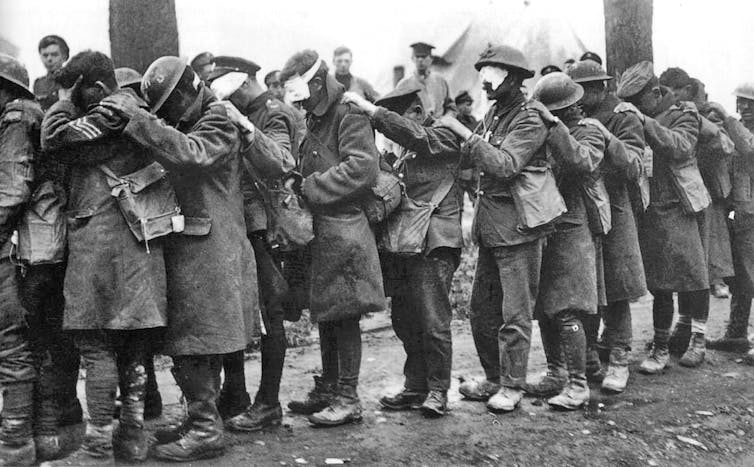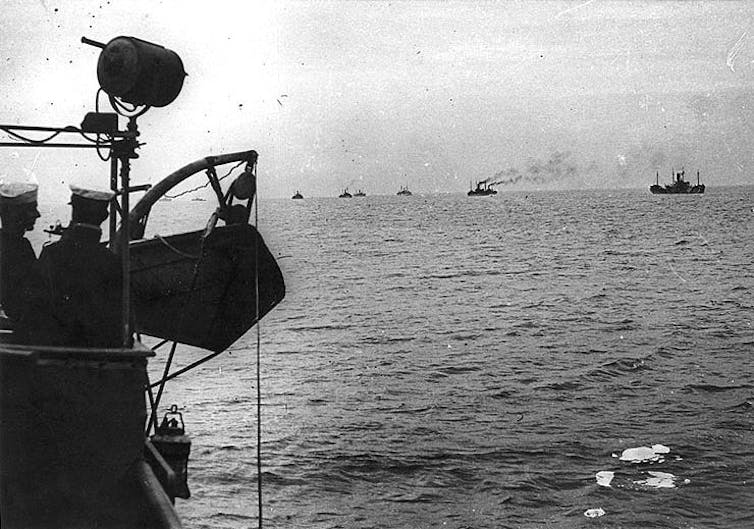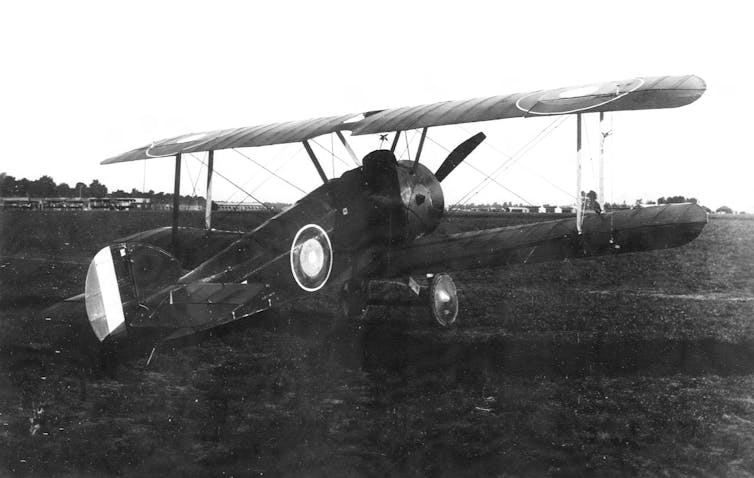Which Of These New Weapons Was Instrumental In Drawing The United States Into World War I
On April 6, 1917, the United States declared war confronting Germany and entered Globe State of war I. Since Baronial 1914, the war between the Central and Entente Powers had devolved into a bloody stalemate, particularly on the Western Front. That was where the U.Southward. would enter the engagement.
How prepared was the state'due south armed forces to enter a modern conflict? The state of war was dominated by industrially made lethal technology, similar no war had been before. That meant more death on European battlefields, making U.Due south. soldiers badly needed in the trenches. But America'southward longstanding tradition of isolationism meant that in 1917 U.South. forces needed a lot of support from overseas allies to fight finer.
In Europe, American gainsay troops would run across new weapons systems, including sophisticated machine guns and the newly invented tank, both used widely during Earth State of war I. American forces had to learn to fight with these new technologies, even as they brought millions of men to bolster the decimated British and French armies.
Engaging with small arms
In certain areas of war machine technology, the United States was well-prepared. The basic infantrymen of the U.Due south. Army and Marine Corps were equipped with the Model 1903 Springfield rifle. Developed later on American experience against German-made Mausers in the Spanish American War, it was an splendid firearm, equal or superior to any rifle in the world at the time.
The Springfield offered greater range and killing power than the U.Southward. Army'south older 30-twoscore Krag. Information technology was also produced in such numbers that it was one of the few weapons the U.Southward. military could deploy with to Europe.

Automobile guns were another matter. In 1912, American inventor Isaac Lewis had offered to give the U.S. Army his air-cooled car gun design for free. When he was rejected, Lewis sold the design to United kingdom and Kingdom of belgium, where it was mass-produced throughout the war.
With far more than soldiers than supplies of modern auto guns, the U.S. Ground forces had to adopt several systems of foreign design, including the less-than-desirable French Chauchat, which tended to jam in combat and proved difficult to maintain in the trenches.
Meeting tank warfare
American soldiers fared better with the Corking State of war's truly new innovation, the tank. Adult from the need to successfully cross "No Man's Land" and clear enemy-held trenches, the tank had been used with limited success in 1917 by the British and the French. Both nations had combat-gear up machines available for American troops.
After the U.Due south. entered the war, American industry began tooling up to produce the French-designed Renault FT light tank. Merely the American-congenital tanks, sometimes called the "six-ton tank," never made it to the battlefields of Europe before the Armistice in November 1918.
Instead, U.S. ground forces used 239 of the French-built versions of the tank, equally well as 47 British Mark 5 tanks. Though American soldiers had never used tanks earlier entering the war, they learned speedily. 1 of the commencement American tankers in World State of war I was then-Captain George Southward. Patton, who later gained international fame as a commander of Allied tanks during Globe War Ii.
Chemical weapons
As well new to Americans was poisonous substance gas, an early form of chemic warfare. By 1917 artillery batteries on both sides of the Western Front commonly fired gas shells, either on their own or in combination with other explosives. Earlier soldiers were routinely equipped with gas masks, thousands died in horrific ways, adding to the already significant British and French prey totals.
Scientists on both sides of the war attempt worked to make gas weapons as effective as possible, including by devising new chemic combinations to make mustard gas, chlorine gas, phosgene gas and tear gas. The American effort was substantial: According to historians Joel Vilensky and Pandy Sinish, "Eventually, more than 10 percent of all the chemists in the United States became directly involved with chemical warfare research during World State of war I."

Naval ability for combat and transport
All the manpower coming from the U.S. would non have meant much without condom transportation to Europe. That meant having a strong navy. The U.S. Navy was the best-prepared and best-equipped of all the state'due south armed forces. For many years, it had been focusing much of its energy on preparing for a surface naval confrontation with Germany.
But a new threat had arisen: Deutschland had made pregnant progress in developing long-range submarines and devising attack tactics that could accept posed severe threats to American shipping. German Navy U-boats had, in fact, devastated British merchant fleets and so badly by 1917 that British defeat was imminent.

In May 1917, the British Royal Navy pioneered the convoy system, in which merchant ships carrying men and materiel beyond the Atlantic didn't travel lonely simply in large groups. Collectively protected past America'southward plentiful armed escort ships, convoys were the key to saving Britain from defeat and assuasive American ground forces to go far in Europe virtually unscathed. In fact, as military machine historian V.E. Tarrant wrote, "From March 1918 until the cease of the war, two million U.S. troops were transported to France, for the loss of only 56 lives."

Taking to the skies
Some of those Americans who fabricated information technology to Europe climbed higher up the rest – right upward into the air. The U.S. had pioneered military aviation. And in 1917, air power was coming into its own, showing its potential well beyond simply intelligence gathering. Planes were condign offensive weapons that could actively appoint footing targets with sufficient force to make a divergence on the battlefield below.

Just with fewer than 250 planes, the U.S. was poorly prepared for an air state of war in Europe. As a result, American pilots had to learn to fly British and French planes those countries could non man.
Despite frequently defective the weapons and technology required for success, it was ultimately the vast number of Americans – afloat, on the basis and in the air – and their ability to adapt and use foreign weapons on foreign soil that helped plough the tide of the state of war in favor of the Allies.
Source: https://theconversation.com/as-the-us-entered-world-war-i-american-soldiers-depended-on-foreign-weapons-technology-75034
Posted by: pullinsciarger.blogspot.com


0 Response to "Which Of These New Weapons Was Instrumental In Drawing The United States Into World War I"
Post a Comment